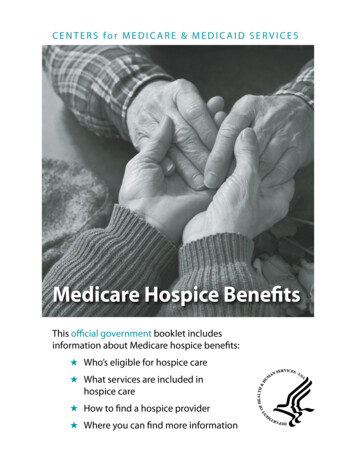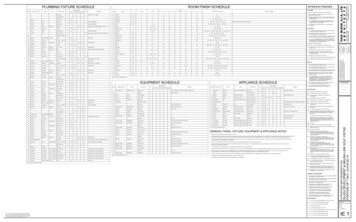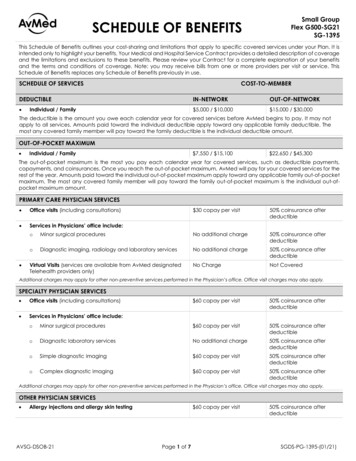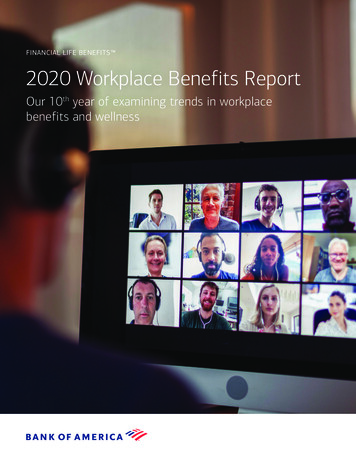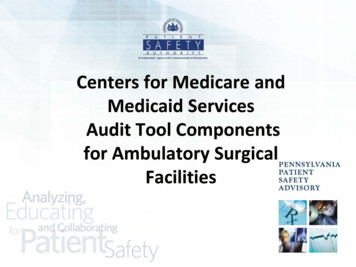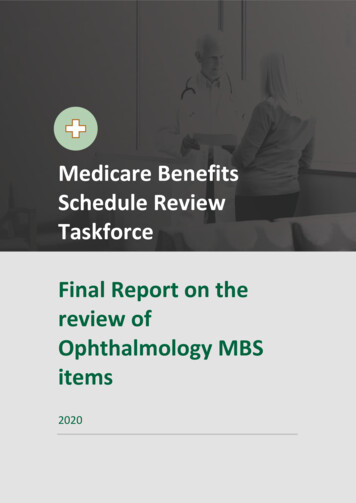
Transcription
Medicare BenefitsSchedule ReviewTaskforceFinal Report on thereview ofOphthalmology MBSitems2020
Important noteThis report contains the final recommendations from the MBS Review Taskforcefollowing the consultation of the Ophthalmology Clinical Committee Report withstakeholders. This report is now subject to consideration by Government.The Taskforce welcomes ongoing feedback on this or any MBS Review report viambsreviews@health.gov.au.Confidentiality of comments:If you would like your feedback to remain confidential please mark it as such. It isimportant to be aware that confidential feedback may still be subject to accessunder freedom of information law.Final Report on the review of Ophthalmology MBS items - 2020Page 2
Table of contents1.1Executive summary . 81.2Key recommendations . 81.31.2.1Compliance . 81.2.2Retinal electrophysiology . 91.2.3Computerised perimetry . 111.2.4Eye injections . 121.2.5Cataract surgery . 141.2.6Obsolete items . 151.2.7Oculoplastic and orbital items . 151.2.8Inappropriate co-claiming . 161.2.9Telemedicine. 161.2.10General recommendations . 171.2.11New items. 171.2.12Cataract surgery and eye injections – questions from the Taskforce . 181.2.13Additional Taskforce recommendations . 18Consumer impact summary . 191.3.1Consumer representative framework . 211.3.2Ophthalmology outcomes . 222 About the Medicare Benefits Schedule (MBS) Review . 242.1Medicare and the MBS . 242.2What is the MBS? . 242.3What is the MBS Review Taskforce? . 242.3.12.4What are the goals of the Taskforce? . 25The Taskforce’s approach . 253 About the Ophthalmology Clinical Committee . 293.1Ophthalmology Clinical Committee members . 293.2Conflicts of interest . 313.3Areas of responsibility of the Committee . 313.4Summary of the Committee’s review approach . 324 Retinal electrophysiology recommendations . 334.1Overview . 334.2Electroretinography, electro-oculography and dark adaptometry . 334.2.1Recommendation 1 . 34Final Report on the review of Ophthalmology MBS items - 2020Page 3
4.2.24.3Rationale for Recommendation 1 . 34Pattern electroretinography . 364.3.1Recommendation 2 . 364.3.2Rationale for Recommendation 2 . 365 Computerised perimetry recommendations . 395.1Overview . 395.2Computerised perimetry . 395.2.1Recommendation 3 . 415.2.2Rationale for Recommendation 3 . 426 Eye injection recommendations . 446.1Overview . 446.2Eye injections . 446.2.1Recommendation 4 . 456.2.2Rationale for Recommendation 4 . 456.2.3Recommendation 5 . 466.2.4Rationale for Recommendation 5 . 466.2.5Recommendation 6 . 466.2.6Rationale for Recommendation 6 . 476.2.7Recommendation 7 . 476.2.8Rationale for Recommendation 7 . 487 Cataract surgery recommendations . 507.17.2Overview . 507.1.1Rural and remote access . 507.1.2Bulk billing . 517.1.3Referral guidelines . 51Cataract surgery . 527.2.1Recommendation 8 . 537.2.2Rationale for Recommendation 8 . 537.2.3Taskforce commentary . 548 Obsolete item recommendations . 558.1Overview . 558.2Obsolete items . 558.2.1Recommendation 9 . 578.2.2Rationale for Recommendation 9 . 579 Oculoplastic and orbital item recommendations . 58Final Report on the review of Ophthalmology MBS items - 2020Page 4
9.1Overview . 589.2Oculoplastic and orbital amendments . 589.2.1Recommendation 10 . 599.2.2Rationale for Recommendation 10 . 6110 Co-claiming recommendations . 6210.1 Overview . 6210.2 Co-claiming restrictions . 6210.2.1Recommendation 11 . 6210.2.2Rationale for Recommendation 11 . 6311 Telemedicine recommendations. 6511.1 Overview . 6511.2 Restructuring telemedicine items . 6511.2.1Recommendation 12 . 6511.2.2Rationale for Recommendation 12 . 6512 General recommendations . 6712.1 Overview . 6712.2 Ongoing review . 6712.2.1Recommendation 13 . 6712.2.2Rationale for Recommendation 13 . 6712.3 Rural and remote incentives . 6712.3.1Recommendation 14 . 6712.3.2Rationale for Recommendation 14 . 6813 New item recommendations . 6913.1 Overview . 6913.2 Glaucoma procedures . 6913.2.1Recommendation 15 . 6913.2.2Rationale for Recommendation 15 . 7014 Cataract surgery and eye injections – questions from the Taskforce . 7114.1 Overview . 7114.2 Questions and recommendations . 7114.2.1Recommendation 16 . 7214.2.2Rationale for Recommendation 16 . 7314.2.3Recommendation 17 . 7314.2.4Rationale for Recommendation 17 . 73Final Report on the review of Ophthalmology MBS items - 2020Page 5
15 Additional Taskforce Recommendations . 7515.1.1Overview. 7515.1.2Recommendation 18 . 7615.1.3Rationale for Recommendation 18 . 7615.1.4Recommendation 19 . 7815.1.5Rationale for Recommendation 19 . 78Case study: Moorfields Eye Hospital NHS Foundation Trust, UK . 81Case study: New Zealand Auckland District Health Board . 8316 Stakeholder impact statement . 84Summary for consumers . 8517 Glossary . 10618 References . 109Final Report on the review of Ophthalmology MBS items - 2020Page 6
List of tablesTable 1 : Ophthalmology Clinical Committee members . 29Table 2 : Item introduction table for items 11204, 11205 and 11211 . 33Table 3 : Item introduction table for item 11210 . 36Table 4 : Item introduction table for items 11221, 11222, 11224 and 11225 . 39Table 5 : Item introduction table for items 42738 and 42739 . 44Table 6 : Item introduction table for item 42702 . 52Table 7 : Item introduction table for items 42741, 42524, 42593, 42783, 42786, 42789, 42792,42806, 42807, 42808 and 43023 . 55Table 8 : Item introduction table for items 42506, 42509, 42510, 42530, 42533, 42536, 42539,42542, 42590, 42593, 42623, 42626, 42629, 42863 and 42866 . 58Table 9 : Item introduction table for items 42632, 42647 and 42773 . 62List of figuresFigure 1: Prioritisation matrix . 28Figure 2: Drivers of ophthalmology item growth, FY2011/12 to FY2016/17 . 32Figure 3: Specialised retinal electrophysiology centres in Australia . 37Figure 4: Item 11204 services per 100,000 population by SA4, ophthalmologists versus otherspecialists, January to March 2018 . 38Figure 5: Item 11221 versus item 10940 services per 100,000 population by age group, FY2016/17 . 43Figure 6: Item 42738 patient count by frequency of services, FY2016/17 . 47Figure 7: Item 42702 socio-economic status of patients, number of services and bulk-billing rate,FY2015/16 . 52Figure 8: Cataract surgery rebate per hour vs other comparable surgical items, FY2016/17 . 54Figure 9 : Eye injections Schedule fee vs other comparable items . 77Figure 10 : Ophthalmology workforce geographic distribution . 79Final Report on the review of Ophthalmology MBS items - 2020Page 7
1.1 Executive summary1.2 Key recommendationsThe 15 members of the Ophthalmology Clinical Committee, led by Chair Dr BradleyHorsburgh, have reviewed 189 items and recommended some level of revision to 31.The MBS Review Taskforce appreciates and recognises their work and carefulconsideration of the relevant MBS items, and broadly supports therecommendations of the Committee.The most important ophthalmology recommendations are summarised below.Five items were considered obsolete and have been recommended for removal fromthe MBS.Detailed recommendations and accompanying rationales for all items, as well asbroader issues, can be found in Sections 4 to 14 of this report.1.2.1ComplianceDuring its review, the Committee identified various opportunities to clarify, applycontemporary clinical standards and practice and update definitions and whenneeded, address compliance issues relating to several items under consideration.These issues are discussed within each relevant item’s detailed recommendation inSections 4 to 14.The Committee recommended improving definitions, which will in-turn improvecompliance and audit functions to identify and prevent low-value use or unintendedor intended misuse of MBS items. Although every effort has been made to align theproposed item descriptors with contemporary best practice, it is not possible (nor isit desirable) to create descriptors that account for every complexity of clinicalmedicine. Improving definitions will clarify how items should be used appropriately,and compliance and audit functions would help to ensure that items are usedappropriately and as intended.Final Report on the review of Ophthalmology MBS items - 2020Page 8
The Committee notes that the Department’s Compliance team is uniquely positionedto identify anomalous behaviour by providers, and believes that Compliance has acritical role to play in preventing and remedying low-value care, which has only beenpartly fulfilled in previous years.The Committee recommended that Compliance work with the Royal Australian andNew Zealand College of Ophthalmologists (RANZCO) to support the effectiveimplementation of these recommendations. For example, RANZCO and MBSCompliance could work together to monitor eye injection frequency which iscurrently reported to the Department of Health (the Department), but not accessedin terms of how many right and how many left eye injections are being carried outon each individual over a year.1.2.2Retinal electrophysiologyThe Committee recommended changing the retinal electrophysiology itemdescriptors to ensure that they are only performed by specialists with suitabletraining and expertise, according to the relevant professional guidelines. TheCommittee also recommended that the Department monitor these clinicians toensure that services are performed in accordance with specified standards of care.These tests are highly specialised and are used to detect retinal disease. They shouldonly be performed in centres that adhere to the required standard of care, specifiedby the International Society for Clinical Electrophysiology of Vision (ISCEV).Restricting item descriptors to ophthalmologistsThe Committee recommended changing the following item descriptors to restrictuse to ophthalmologists, or a technician on behalf of an ophthalmologist:Item 11204: Electroretinography.Item 11205: Electro-oculography.Item 11211: Dark adaptometry.Final Report on the review of Ophthalmology MBS items - 2020Page 9
The Committee noted that items 11204 and 11205 were recently changed (effectiveNovember 2017) to exclude claiming by general practitioners (GPs). This amendmenthas been effective, with no services claimed by GPs in 2018. However, theCommittee felt that further restrictions were required due to:Significant geographic variation in service provision.A higher than expected number of clinicians claiming these items.The broad range of specialty clinicians co-claiming item 11205. Ophthalmologistsonly claim 1 per cent of episodes. Neurologists claim the majority of episodes(50 per cent), indicating significant and broad indication creep.Restricting use of items to specialistsThe Committee recommended changing the descriptor for item 11210 (patternelectroretinography) to restrict use to specialists, excluding GPs.A variety of specialists claim this item (in addition to ophthalmologists), includingneurologists, general surgeons, paediatricians and GPs. The purpose of thisrecommendation is to exclude GPs from using this highly specialised item,recognising the appropriate equipment and training/expertise necessary.This will prevent claims for services that are not provided in accordance with theitem descriptor.Other specialists have not been restricted from using this item. Unlike items 11204,11205 and 11211, specialists other than ophthalmologists (mainly neurologists) havethe requisite equipment and expertise to perform and interpret this test.Monitoring service provisionThe Committee recommended that the Department investigate clinicians claimingitems 11204, 11205 or 11211 who are not located in areas with specialised retinalelectrophysiology centres.Final Report on the review of Ophthalmology MBS items - 2020Page 10
The Committee suspects that some clinicians are using these items in a manner thatdoes not comply with best-practice standards of care, which are referenced in theitem descriptors and detailed in the explanatory notes.1.2.3Computerised perimetryThe Committee respectfully recommended that the Optometry Clinical Committeeinvestigate the optometric computerised perimetry items for possible inappropriateuse.Computerised perimetry has become the standard of care in optometric andophthalmic practice for the assessment and monitoring of the visual field defectscaused by glaucoma. These are not screening tests and should be performed forspecified indications only.The Committee noted that computerised perimetry services performed byophthalmologists appear to be in line with expectations, with the rate of servicingincreasing exponentially with age (in a similar way to glaucoma prevalence rates).However, service rates by age and growth for optometric item 10940 do not appearto be in line with expectations. Service growth for item 10940 was double the rate ofcomparable ophthalmology items (8 per cent and 4 per cent per year, respectively).The rate of servicing also did not increase exponentially with age. Instead, it droppedoff for patients aged 80 years and above, and was higher than expected for thoseaged 50 and below. The Committee felt that this may indicate that computerisedperimetry is being used as a screening tool.The Committee recognised that the optometric items are beyond its remit butwished to acknowledge the need for better targeting of patients for testing. Thiswould allow for a higher rate of glaucoma assessment and represents an opportunityfor collaborative research between ophthalmologists and optometrists to achievethe best monitoring rates for glaucoma patients.Final Report on the review of Ophthalmology MBS items - 2020Page 11
Please note: The Taskforce asked the Optometry Committee as part of its discussionsto provide clarification on the usage of its Computerised Perimetry items. Below isthe response from Optometry Clinical Committee.1. An increasing number of therapeutic optometrists who are highly skilled atdetecting, monitoring and treating a wide range of eye diseases.2. A dramatic increase in the availability of optical coherence tomography (OCT)OCT has revolutionised ophthalmic care, enabling far earlier diagnosis ofconditions such as glaucoma, exudative macular degeneration and diabeticmacular oedema.3. Optometrists are primary eyecare practitioners who use visual fields as part of adiagnostic test regime on indication as per the schedule. Optometrists conductover 75% of all eye examinations in Australia and need to differentiate thenormal and healthy against conditions and diseases of the eye and visualpathway.This response was accepted by the Taskforce in December 2018.1.2.4Eye injectionsCreating separate items for eye injections for the left and right eyeThe Committee recommended creating two separate items for eye injections—onefor the left eye and one for the right eye—to allow for appropriate monitoring oftreatment frequency.The Committee noted that Medicare cannot provide searchable per-eye data. Thisinformation is crucial to determine and monitor treatment frequency, which occurson a per-eye basis.Very low frequency treatment (fewer than three injections a year in each eye, perpatient) and very high frequency treatment (more than 12 injections a year in eacheye, per patient) may represent low-value care.Final Report on the review of Ophthalmology MBS items - 2020Page 12
Monitoring treatment frequencyThe Committee recognised the need to monitor treatment frequency for item 42738due to:High service growth of 14 per cent per year between the 2013/14 financial year(FY) and FY2017/18 (although the Committee noted that this rate is expected todecline in the coming years).Large variation in the frequency of injections per patient.Providing clinician educationThe Committee recognised that RANZCO can play a role in educating clinicians onappropriate treatment frequency, and that MBS Compliance can support theseefforts through an audit of treatment frequency.A panel of experts from the Australian and New Zealand Society of Retinal Specialistscould formulate clinical practice guidelines for the use of intravitreal anti-vascularendothelial growth factor (anti-VEGF) therapy and these could then be incorporatedinto the item descriptor.Limiting in-hospital treatmentThe Committee recommended restricting the patient setting to outpatient byreclassifying item 42738 as a Type C procedure, with an exclusion for ModifiedMonash Model1 (MMM) regions 5, 6 and 7. A Type C procedure does not normallyneed hospital treatment and requires clinicians to fill out a form to justify in-hospitaluse.The Committee noted that in-hospital treatment for intravitreal eye injections shouldoccur in fewer than 3 per cent of patients. It currently occurs in 18 per cent ofpatients, and this number is increasing. This is largely unnecessary and may be dueto financial incentives. Evidence supporting this recommendation includes RANZCO’sFinal Report on the review of Ophthalmology MBS items - 2020Page 13
Choosing Wisely guidelines, as well as rates of in-hospital services in otherjurisdictions (for example, rates of 1–2 per cent in the United States).1.2.5Cataract surgeryThe Committee has not recommended item-level changes but has commented onthree issues relevant to cataract surgery: rural and remote access, bulk billing andreferral guidelines.Rural and remote accessThe Committee recognised the logistical difficulties in servicing rural and remoteareas for cataract surgery.It further noted that inequity in access extends to all eye services.It has made a general recommendation to incentivise rural and remoteophthalmology services. (Recommendation 14, Section 12.3).Bulk billingThe Committee recognised that the bulk-billing rate for cataract surgery is low, withan average rate of 3.5 per cent.It also noted that the bulk-billing rate only varies slightly across socio-economicgroups, ranging from 2.0 per cent in the least disadvantaged group to 5.9 per cent inthe most disadvantaged group in FY2015/16.The Committee agreed that this low bulk-billing rate may be driven by additionalcosts of cataract surgery that are not covered by the MBS. These cos
1.2.2 Retinal electrophysiology The Committee recommended changing the retinal electrophysiology item descriptors to ensure that they are only performed by specialists with suitable training and expertise, according to the relevant professional guidelines. The Committee also re
